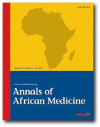
|
Annals of African Medicine
Annals of African Medicine Society
ISSN: 1596-3519
Vol. 4, No. 3, 2005, pp. 122-126
|
 Bioline Code: am05031
Bioline Code: am05031
Full paper language: English
Document type: Research Article
Document available free of charge
|
|
|
Annals of African Medicine, Vol. 4, No. 3, 2005, pp. 122-126
| en |
Lupus Anticoagulant in Nigerian Children With Homozygous Sickle Cell Disease
Olayemi, E.; Halim, N.K.D.; Durosinmi, M.A. & Awodu, O.A.
Abstract
Background:
Lupus anticoagulant (LA) is an antiphospholipid antibody (APLA), which recognise combinations of phospholipids or phospholipid -binding proteins or both and interfere with coagulation reactions dependent on protein phospholipid complexes in vitro. LA has paradoxically been associated with thrombosis and a myriad of clinical conditions such as cerebrovascular accidents (CVA). APLA have been described in adult homozygous sickle cell disease (SCD) patients and adults with β- thalassaemia. Our objective was to determine the presence or otherwise of LA in children with homozygous SCD and to see if they were more prone to developing LA compared to normal HbAA controls.
Method:
A total of 57 children with homozygous SCD between the ages 1-15 years were prospectively screened for the presence of LA using the kaolin clotting time (KCT), while 52 healthy HbAA children served as controls. KCT was performed in duplicates on all 109 subjects. Kaolin clotting time ratio was calculated to determine the presence of LA. A ratio greater than or equal to 1.2 was taken to signify the presence of LA.
Results:
One (1.8%) child with homozygous SCD had prolonged KCT, and this was not corrected by normal plasma, the KCT ratio was greater than 1.2, signifying the presence of LA. None of the control subjects had LA (p >0.05).
Conclusion:
One (1.8%) child in this study had LA; this value was not statistically significant when compared with HbAA controls. In spite of the fact that secondary LA is more common in females, the only patient with LA in our study was male and had no prior history of CVA or thrombosis.
Keywords
Lupus anticoagulant, Nigerian children, homozygous sickle cell disease
|
| |
| fr |
Olayemi, E.; Halim, N.K.D.; Durosinmi, M.A. & Awodu, O.A.
Résumé
Fond :
L'anticoagulant de lupus (AL) est un anticorps antiphospholipide (AAPL), qui identifie les combinaisons des phospholipides ou du phospholipide protéines liantes ou toutes les deux et qui interfère avec des réactions de coagulation qui dépendent sur les complexes phospholipide de protéine en vitro. L'AL a été paradoxalement associée à la thrombose et à une myriade de conditions cliniques tels que les accidents cérébrovasculaires (ACV). AAPL ont été décrits dans des malades adultes de drépanocytose homozygote et adultes de drépanocytose homozygote et des adultes avec la thalassémie de b. Notre objectif était de déterminer la présence ou autrement d'AL chez les enfants avec drépanocytose homozygote et pour voir s'ils étaient plus en pronation au développement d'AL en comparaison avec les commandes normales de HbAA.
Méthode :
Un total de 57 enfants avec drépanocytose homozygote entre les âges 1-15 ans étaient prospectivement examinés pour la présence de l'Al en utilisant le temps de coagulation de kaolin (TCK), tandis que 52 enfants en bonne santé de HbAA servaient de commandes. Le TCK a été exécuté en reproductions sur chacun des 109 sujets. La proportion de temps de coagulation de kaolin a été calculée pour déterminer la présence de l'AL. Une proportion supérieure ou égale à 1,2 a été prise pour signifier la présence de l' AL.
Les résultats :
Un (1,8 %) enfant avec drépanocytose homozogote avait prolongé le TCK, et ceci n'a pas été corrigé par le plasma normal, la proportion de TCK était plus grande que 1,2, signifiant la présence de l'AL. Aucun des sujets de contrôle n'avait AL (p>0,05).
Conclusion :
Un (1,8%) enfant dans cette étude a eu l'AL ; cette valeur n'était pas statistiquement significative en comparaison avec des commandes de HbAA. Malgré le fait que l'AL secondaire est plus commune dans les femelles, le seul malade avec l'AL dans notre étude était un mâle et n'a eu aucune histoire antérieure de ACV ou de thrombose.
Mots Clés
Anticoagluant de lupus, enfants nigérians, le drépanocytose homozogote
|
| |
© Copyright 2005 - Annals of African Medicine
Alternative site location: http://www.annalsafrmed.org
|
|
